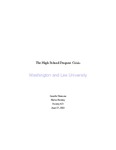| dc.rights.license | In Copyright | en_US |
| dc.creator | Niemann, Jennifer | |
| dc.date.accessioned | 2013-12-10T15:44:00Z | |
| dc.date.available | 2013-12-10T15:44:00Z | |
| dc.date.created | 2008 | |
| dc.identifier | WLURG38_Niemann_POV_2008_wm | |
| dc.identifier.uri | http://hdl.handle.net/11021/24218 | |
| dc.description | Jennifer Niemann is a member of the Class of 2008 of Washington and Lee University. | en_US |
| dc.description | Capstone; [FULL-TEXT FREELY AVAILABLE ONLINE] | en_US |
| dc.description.abstract | Over the past 4 decades, the U.S. economy has transformed into a globally competitive market which places a premium on knowledge and education, where the high school diploma is now “an increasingly important prerequisite for economic and social mobility in the United States." High school dropout status has evolved into a debilitating characteristic often leading to poverty crime and dependency even as expenditure s on education have soared. Despite these developments, only about 70% of students graduate on time with a regular diploma: an astounding one million children drop out of high school every year. Although an individual's investment in education should rise as the benefits to graduation increase, the dropout rate has actually increased from 23% to 30% over the past three decades. While dropping out is a national problem, minority students, lower-income students, inner-city students, and those attending highly segregated schools all drop out at significantly higher rates than their peers. There are significant individual, familial, and community costs of dropping out of high school. High dropout rates may handicap a huge segment of the population, exacerbating poverty. School reform has concentrated on improving academic achievement, not graduation rates. It is necessary to learn more about discover the causes of this dropout crisis in order to prevent the creation of a permanent underclass whose potential is so limited by the lack of a high school diploma. [From "Identifying the Problem"] | en_US |
| dc.description.statementofresponsibility | Jennifer Niemann | |
| dc.format.extent | 29 pages | en_US |
| dc.language.iso | en_US | en_US |
| dc.rights | This material is made available for use in research, teaching, and private study, pursuant to U.S. Copyright law. The user assumes full responsibility for any use of the materials, including but not limited to, infringement of copyright and publication rights of reproduced materials. Any materials used should be fully credited with the source. | en_US |
| dc.rights.uri | http://rightsstatements.org/vocab/InC/1.0/ | en_US |
| dc.subject.other | Washington and Lee University, Shepherd Poverty Program | en_US |
| dc.title | The High School Dropout Crisis | en_US |
| dc.type | Text | en_US |
| dcterms.isPartOf | RG38 - Student Papers | |
| dc.rights.holder | Niemann, Jennifer | |
| dc.subject.fast | Dropouts -- Employment | en_US |
| dc.subject.fast | High school dropouts -- Prevention | en_US |
| dc.subject.fast | Parent and child -- Psychological aspects | en_US |
| dc.subject.fast | School attendance | en_US |
| dc.subject.fast | Social capital (Sociology) | en_US |
| dc.subject.fast | High school student activities | en_US |
| local.department | Shepherd Poverty Program | en_US |
| local.scholarshiptype | Capstone | en_US |
